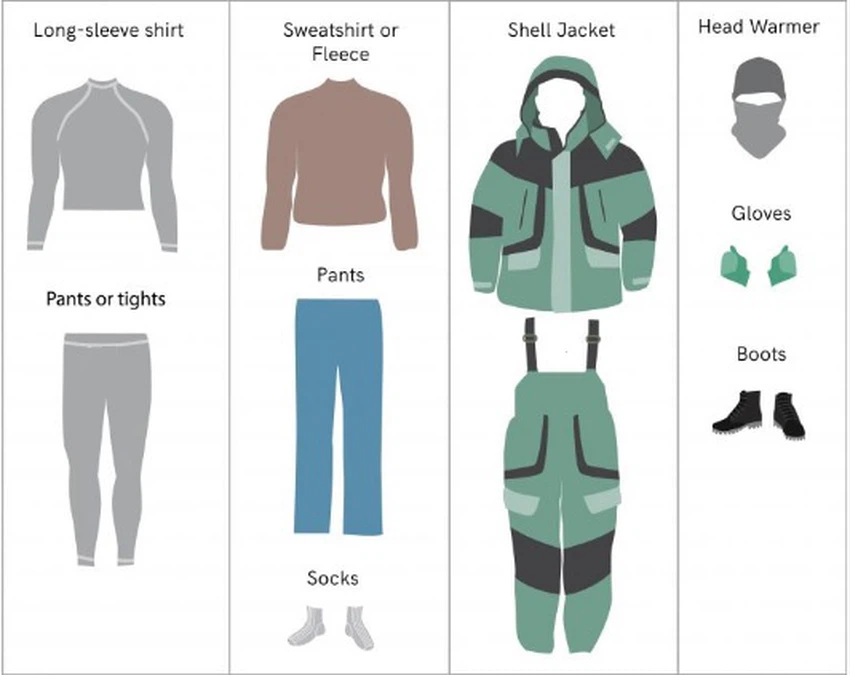Which is warmer in winter: wearing several thin layers of clothing or one thick layer?
Weather of Arabia - With the temperature dropping in winter, people seek to get warm in different ways, and the most important of these ways is to wear warm winter clothes, but why do we need to wear heavy clothes in winter? Which is better and warmer in winter: several thin layers of clothing or one thick layer?
Why do we need to wear heavy clothes in winter?
Humans are classified as warm-blooded creatures, which are creatures that can maintain the stability of their body temperature despite the change in the temperature of the surrounding environment, so warm-blooded organisms need to maintain their bodies warm in some way in the winter, and while wild animals have a cover on Their bodies of hair, fur, wool or feathers protect them from the cold, and humans resort to wearing heavy clothes.
Is it better to wear several thin layers of clothing than one thick layer?
To answer this question, we must first understand the way in which clothing works to warm us, as clothing is considered a poor conductor of heat, so it maintains the warmth of the air in contact with our bodies, and thus prevents the loss of body heat, and protects us from feeling cold.
Therefore, the multiplicity of pieces we wear has a greater effect on our warmth than its thickness, that is, wearing more than one layer of clothing makes us warmer than wearing one thick layer, because multilayering keeps more warm air under it, but some parts of the body - such as arms, legs and feet It requires heating more than others because it is far from the heat centers in our bodies.
The texture of the clothing is also important, while cotton and linen absorb excess moisture, wool can retain heat, so it is recommended to wear wool clothing with a layer of cotton clothing underneath to keep the skin warm and protected from excess moisture.
What layers of clothing keep our bodies warm best?
A single piece of thick clothing does not provide as much warmth as several layers of light clothing, and the reason for this is the air trapped between each layer of clothing, as the body radiates heat and heats this air, so each surrounding layer becomes a self-shield that protects you from Cold, but the correct method of wearing layers must be followed for better protection from the cold, which is in the following order:
1. Base layer - to absorb moisture
It is the first layer of clothing that comes into contact with the skin, so it must be able to remove moisture, as heat can activate sweating, and damp skin can lead to rapid heat loss in cold weather.
So the base layer should have moisture-wicking properties, like cold-weather sportswear, which provide the best balance between lightweight fabric and moisture-wicking properties, adding a little bulk, allowing for a lot of flexibility in movement, and for the feet thick socks can be worn over socks Essential to keep feet dry.
2. Insulating layer - to retain heat
This layer should have the same heat retention properties as natural fibers such as wool, as wool can absorb about 30% of its weight in moisture without getting wet, and can provide some insulation when wet.
Sweaters, such as those made from angora and cashmere, are warm and elegant. A good cardigan with a plain cotton shirt can provide enough warmth on cold days.
And then there's the synthetic wool, it's lightweight and insulates well even when wet, however, it needs layers with a tight, windproof fabric to provide protection from the wind.
To warm the legs, thick woolen trousers can be worn over a base layer. It is preferable to avoid jeans. Jeans are good as light protective clothing, but should be avoided in cold areas because they do not have any insulating properties, but they can be combined with an inner insulation layer for more warmth.
3. Protective Layer - To protect the layers underneath
This layer keeps all the inner layers protected, this layer may not have any insulating properties and does not provide warmth, but it should stop the wind from entering the body and trap warm air inside, while being able to allow moisture to escape.
A layer of weather-resistant gloves (rain and wind), a fleece sock, a hat, a scarf and good winter boots, the best winter boots are boots with soft sides, lined with natural fibres, with insulation and a thick, flexible sole.

(The three basic layers to wear in cold winters)
The importance of appropriate layers of clothing
Layers of clothing must allow freedom of movement, and the base layer must always be snug and in contact with the body to be effective, as such clothing usually contains an elastic or other stretchy material to always be close to the body.
Insulating layers of clothing should range from thin and narrow to thick and loose, as a lighter fleece jacket will not provide effective insulation if worn over a bulky jacket.
For the outer layers, choose layers that have a few spaces between them and the insulation layers, this will help in the flow of air and moisture.
Arabia Weather App
Download the app to receive weather notifications and more..



